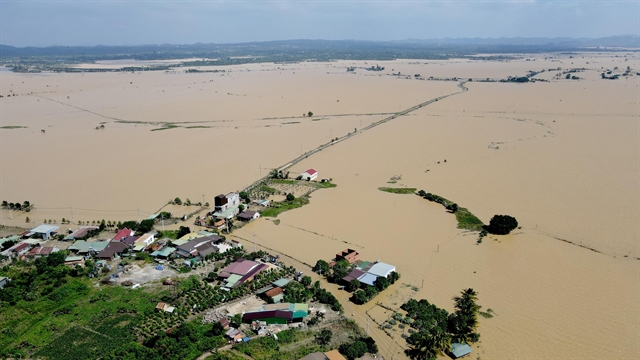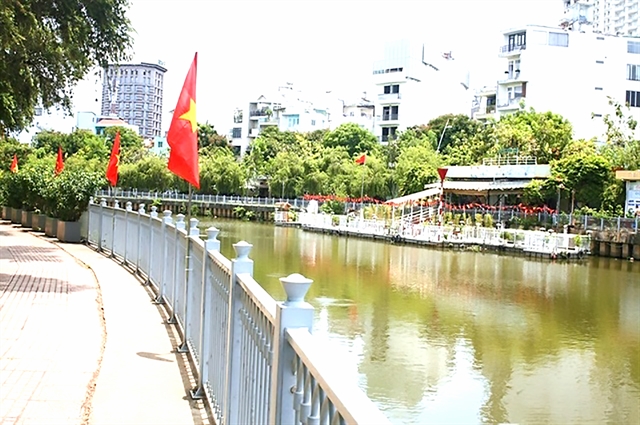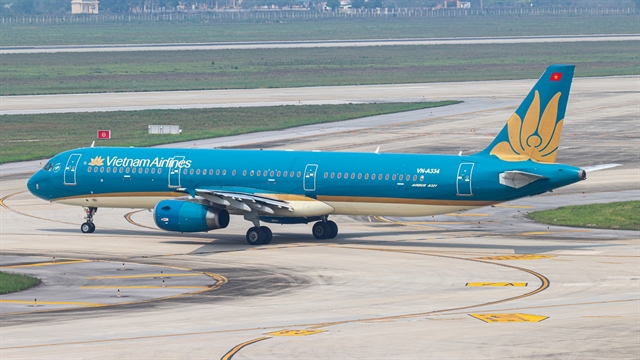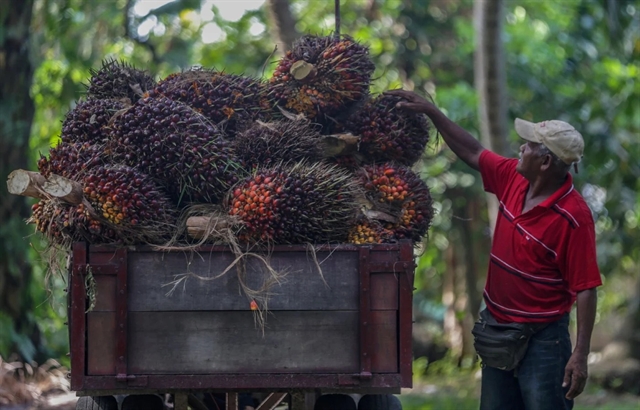 Society
Society

 |
| The Nhiêu Lộc - Thị Nghè Canal transformed into a clean, modern and scenic waterway. Photo nld.com.vn |
HCM CITY — As HCM City continues to develop economically and socially, it is also focusing on becoming a more livable city by enhancing air quality and expanding green spaces.
Both local communities and city authorities have proactively created, nurtured, and preserved green areas to improve the quality of life.
A prime example is the Trường Sa Garden next to Võ Trường Toản Primary School in District 10, which was transformed from a former landfill into a vibrant park complete with flowers and beautiful landscaping.
Covering an area of 72 square meters, the garden won first prize in the third "Clean - Green - Environmentally Friendly Project Building Competition" based on community participation in 2024, organised by the Việt Nam Fatherland Front (VFF) Committee of HCM City in collaboration with the Department of Natural Resources and Environment.
Resident Nguyễn Ngọc Trân shared that the area previously suffered from stagnant water, mosquito breeding, accumulated trash, and foul odors.
The transformation into a flower garden not only improved the appearance of the neighbourhood but also made it cleaner and healthier, she said.
"The transformation of this area was not solely the result of government efforts but also the collective contribution of individuals and the local community."
In fact, numerous pocket parks have sprung up across the city, reclaiming polluted and neglected spaces.
Examples include the mini-park in Alley 1041 on Trần Xuân Soạn Street (District 7), the heart-shaped lake park in Vĩnh Lộc Residential Area (Bình Tân District), the park in Alley 2695 on Phạm Thế Hiển Street (District 8), and a 1,000-square-meter community vegetable garden on Street No. 13 in Cát Lái Ward (Thủ Đức City).
At a larger scale, the city has developed riverside parks and open spaces to protect the environment, such as Bạch Đằng Wharf Park (District 1), the parks along the Nhiêu Lộc - Thị Nghè Canal, the Saigon Riverbank Park, and the Creative Park in Thủ Đức City.
These parks not only serve as popular recreational areas but also contribute to river landscape restoration and prevent canal encroachment.
Every morning and evening, many citizens gather at these parks for walking and exercising, creating a dynamic and environmentally friendly urban rhythm.
Boosting mental and physical health
Experts agree that as HCM City undergoes rapid urbanisation, with an increasing number of vehicles and bustling economic activity, environmental challenges such as the "urban heat islands" effect and air pollution have emerged.
In this context, expanding green spaces is seen as vital not only for beautifying the city but also for regulating the climate.
According to Lê Đình Quyết, Head of the Forecasting Department at the Southern Regional Hydrometeorological Station, planting more trees is an effective way to enhance living standards and protect public health in times of climate change and rapid urbanisation.
Green spaces can significantly lower urban temperatures—parks can reduce air temperatures by 2 to 4 degrees Celsius compared to areas without trees.
Moreover, green spaces offer places for relaxation, physical exercise, and mental rejuvenation.
"HCM City must continue to invest heavily and develop long-term strategies to expand green spaces, building a livable city where people coexist harmoniously with nature," Quyết emphasised.
Resident Trần Quý Kim lives in District 1 and also enjoys the benefits of the city's green initiatives.
She regularly jogs at Bạch Đằng Wharf Park, describing it as an open, refreshing riverside space perfect for gatherings with family and friends during special events such as National Day, Liberation Day, or New Year's celebrations.
Greener spaces, healthier city
Under the 2020–2025 master plan, the City aims to add 10 hectares of new public green spaces, plant and rehabilitate 30,000 trees, and increase public parkland by 150 hectares, raising the public park area per capita by 0.65 square metres.
By December 2024, the city had achieved impressive results including 237.51 hectares of new public parks developed (158 per cent of the original target), 54 hectares of new public green space added (540 per cent of the target) and 42,534 trees planted or rehabilitated (140 per cent of the target).
Looking toward to 2030, the city targets at least one square metre of green space per capita, another 10 hectares of new green space, and 50,000 newly planted or rehabilitated trees.
Priority will be given to developing large, multifunctional, and modern parks, especially in suburban districts and densely populated areas.
Additionally, existing parks will be upgraded with more amenities to meet diverse public needs.
The HCM City Urban Infrastructure Investment Project Management Board is currently implementing three green park projects in Củ Chi District and District 12 including Tân Thạnh Tây Park, Tân Chánh Hiệp Park, and Thạnh Lộc Park. Once completed, these projects will add over seven hectares of new parkland.
To meet the ambitious targets for green space expansion by 2030, the board emphasises the need for active collaboration and support from various departments, sectors, and localities, ensuring a greener, healthier and more livable city.
In addition to developing and upgrading parks, the city is also placing strong emphasis on flood prevention and wastewater management, bringing new life to its canal systems.
 |
| People enjoy recreational activities at Bạch Đằng Wharf Park in HCM City's District 1. Photo nld.com.vn |
Breathing new life into the canals
The city has launched a comprehensive plan this year to dredge and rehabilitate polluted canals and waterways.
Among the key projects is the dredging and environmental restoration of the Xuyên Tâm Canal—one of the most polluted canals in the city—stretching 8.8 kilometres from the Nhiêu Lộc - Thị Nghè Canal to the Vàm Thuật River.
This project, passing through Gò Vấp and Bình Thạnh districts, carries a total investment of VNĐ17.2 trillion (approximately US$688 million).
According to the Urban Infrastructure Construction Investment Project Management Board, the project is scheduled to be completed before April 30, 2025, in celebration of the 50th anniversary of the Liberation of South Việt Nam and national reunification.
Simultaneously, the restoration of the northern bank of the Đôi Canal in District 8 is progressing rapidly.
Once completed, both the Xuyên Tâm Canal and Đôi Canal projects are expected to significantly reduce environmental pollution and bring a renewed vitality and improved urban landscape for surrounding residents.
Meanwhile, the construction and environmental improvement of the Tham Lương - Bến Cát - Nước Lên Canal system - connecting Long An Province via the Chợ Đệm River and linking Bình Dương and Đồng Nai provinces through the Saigon River - is also nearing completion.
These infrastructure projects are transforming the region's appearance, enhancing urban aesthetics, boosting living standards, easing traffic congestion, and facilitating the transportation of goods in the western part of the city.
Previously, the successful rehabilitation of the Nhiêu Lộc - Thị Nghè and Tàu Hủ - Bến Nghé canals turned them into lush green corridors, creating ideal living spaces.
Today, these revitalised waterways significantly contribute to the city's socio-economic development.
Expanding wastewater treatment capacity
Alongside the green canal restoration efforts, HCM City is also investing heavily in wastewater treatment infrastructure.
A major milestone was the recent completion of the expansion of the Bình Hưng Wastewater Treatment Plant and its associated collection system.
The plant, now capable of treating 469,000 cubic metres of wastewater per day, serves Tàu Hủ,Bến Nghé, Đôi and Tẻ canal basins.
Plans are already in place to further increase the plant’s treatment capacity to 512,000 cubic metres per day, enabling it to handle wastewater from the Tẻ Canal area in District 7.
The entire Tàu Hủ, Bến Nghé, Đôi and Tẻ canal system will be restored to clean, vibrant waterways, paving the way for advancements in economic development, tourism, inland waterway transport, and the overall quality of life of millions of city residents. — VNS




